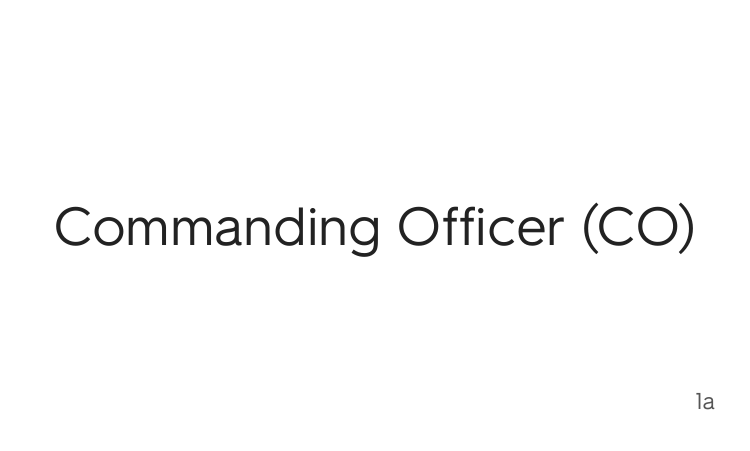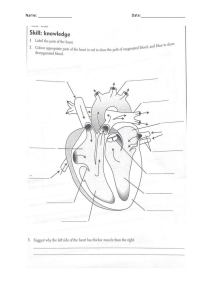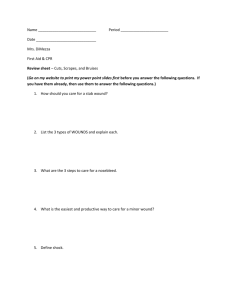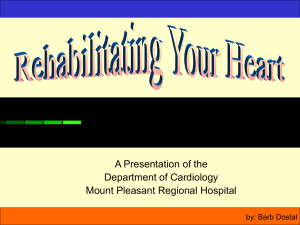
Commanding Officer (CO) 1a Responsible for those under their command and their actions. Navy regulations, general orders, customs, and tradition establish the CO duties. 1b Executive Officer (XO) 2a Organization, performance of duty, and good order and discipline of the entire command. Direct representation of the CO. 2b CMC/Senior/Chief 3a Formulation and implementation of policies relevant to morale, welfare, job satisfaction, discipline, utilization and training of enlisted personnel. 3b Department Head (DH) 4a Reports to the CO in matters pertaining to the operational readiness of the department. Responsible for effective administrative, operation, duties, and personnel assigned to the department. 4b Command Managed Equal Opportunity Officer (CMEO)/Equal Opportunity Program Specialist (EOPS) 5a Develops and establishes criteria for implementation, monitoring, and evaluation of the EO program. 5b Division Officer (DO) 6a Responsible to the DH for the performance of assigned duties and operational readiness of the division. Responsible for the conduct, training, and professional growth of subordinates. 6b Leading Chief Petty Officer (LCPO)/Leading Petty Officer (LPO) 7a Designated by division Officer. LCPO assist the division Officer in administering, supervising, and training division personnel. LPO assist the LCPO and DO. 7b Command Career Counselor (CCC) 8a Establish and Maintain an effective career counseling program by spreading information and providing career guidance, counseling, and interviews to personnel. Ensure current programs are Available to all crew members. 8b Work Center Supervisor (WCS) 9a Primary job is to respond to the hour by hour work center functions. 9b Ombudsman 10a CO appointed. Link between the command and families of command personnel. Keep CO informed about family morale and problems families are facing. 10b Financial Specialist (CFS) 11a Provides financial counseling and assistance to members in their command. May include budgets, financial planning, etc 11b Drug and Alcohol Program Advisor (DAPA) 12a Responsible directly to the CO for command implementation of the Navy Alcohol and other Drug Abuse Program(NADAP). Conduct personnel screenings and Command Awareness education, monitor aftercare, command referral agent, and prepare reports and correspondence. 12b Security Manager 13a Responsible to the CO for all matters involving security of classified information. Document classification management, personnel security. 13b Career Information Program Management (CIPM) Program Manager 14a Department and division career counselors to provide career information to the squadron, department, division, and work center personnel. 14b Naval Message 15a Written thoughts , ideas, or information briefly expressed and to the point. Principal means Commanders Communicate. Transmitted electronically to avoid delays. 15b E-mail 16a Informal method of corresponding electronically by computers. Can be used within individual activities or between activities/units. 16b Enlisted Service Record pg.2 17a Emergency data and dependent information. Used as a reference should the service member be killed. 17b Enlisted Service Record pg.4 18a Enlisted Qualifications History. Chronological history of occupational and training related qualifications, awards, and commendations. 18b Enlisted Service Record pg.13 19a Administrative Remarks. Record of significant miscellaneous entries that aren't provided elsewhere or where detailed information may be required to clarify entries elsewhere in service record. 19b Enlisted Distribution Verification Report (EDVR) 20a Monthly statement of an activity's enlisted personnel used heavily by the CMC & detailers for billet assignment. Summary of the present and future manning status. 20b Operational Report (OPRREP) 21a Used by a unit to provide the National Command Authorities and Appropriate naval commanders with immediate notification of any accidental or unauthorized incident involving a possible detonation of a nuclear weapon. Has Highest precedence. 21b Movement Report (MOVEREP) 22a Primary source of location information concerning ships. Assist COC all the way up national Command authorities on the location, tracks, and destination of all vessels for emergency or operational use. 22b Logistical Requirements (LOGREQ) 23a Submitted by a ship prior to entering a port to notify the proper commands of its logistics requirements while visiting that location. Should arrive at destination port no later than 48 hours prior to the ship arrival. 23b Status of Requirement and Training Support (SORTS) 24a Reports the ship's status of conditions of readiness in all warfare areas in our ability to conduct operations. 24b Situation Report (SITREP) 25a Used by any CO, Officer in charge, or other commander to provide appropriate operational commanders and higher authority with timely notifications of any incident not meeting OPREP-3 special incident reporting criteria. 25b 3 objectives of First Aid 26a Prevent further injury, infection, & death 26b How many categories can the fundamental elements of first aid be categorized in? 27a 8 main areas 27b Four methods of controlling bleeding? 28a Direct pressure, elevation, pressure points, & tourniquet as a last result 28b What's a pressure point? 29a Point on body where a main artery lies near the surface of the skin and over a bone 29b To reduce or stop blood flow to areas of the body by? 30a Applying physical pressure 30b How many principal pressure points? 31a 11 31b Superficial temporal artery 32a Temple 32b Facial artery 33a Jaw 33b Common carotid artery 34a Neck 34b Subclavian artery 35a Collar bone 35b Brachial artery 36a Inner elbow & upper arm 36b Radial/Ulnar artery 37a Wrist 37b Femoral artery 38a Upper thigh 38b Iliac artery 39a Groin 39b Popliteal artery 40a Knee 40b Anterior/posterior tibial artery 41a Ankle 41b The three classifications of burns? 42a First, second, and third degree 42b Produces redness, warmth and mild pain 43a First degree 43b Causes red, blistered skin and severe pain 44a Second degree 44b Destroys tissue, skin and bone. In severe cases severe pain may be absent due to nerve endings being destroyed 45a Third degree 45b 2 types of fractures? 46a Closed/Simple & Open/Compound 46b Closed/Simple 47a Broken bone w/o a break in the skin 47b Open/Compound 48a Break in skin with possible bone protrusion 48b Electric Shock 49a Contact with an electronic energy source shock occurs. Little to no injury to severe trauma with associated cardiac arrest 49b Indications of obstruction airway ? 50a Inability to talk, grasping and pointing to throat, exaggerated breathing efforts, & skin turning a bluish color 50b 2 type of heat related injuries? 51a Heat exhaustion & Heat stroke 51b Heat exhaustion 52a Disturbance of blood flow to the brain, heart, and lungs 52b Heat Stroke 53a Breakdown of the sweating mechanism of the body 53b 3 types of cold weather injuries? 54a Hypothermia, superficial and deep frostbite 54b Hypothermia 55a Cooling of the whole body caused by exposure to low temperature. Breathing is slow & shallow. 55b Superficial Frostbite 56a Ice crystals forming in upper skin layers after exposure to temperature of 32 degrees or lower 56b Deep frostbite 57a Ice crystals forming in the deeper tissues after exposure to temperature of 32 degrees or lower 57b Cardiopulmonary Resuscitation (CPR) 58a CPR is a combination of rescue breathing & chest compressions delivered to victims thought to be in cardiac arrest 58b CPR steps 59a C/A/B (Circulation/Airway/Breathing) 59b Key to survival for victims of cardiac arrest? 60a Prompt recognition of the arrest and immediate activation of the emergency response system 60b Septic Shock 61a Results from bacteria multiplying in the blood and releasing toxins. 61b Anaphylactic Shock 62a Severe hypersensitivity or allergic reaction. Causes allergy to insect stings 62b Cardiogenic Shock 63a Heart is damaged and unable to supply sufficient blood to the body 63b Hypovolemic Shock 64a Severe blood and fluid loss which makes the heart unable to pump enough blood to the body 64b Neurogenic Shock 65a Spinal cord injury result of a traumatic accident or injury 65b ORM 66a Systematic, decision making process used to identify and manage hazards that endanger naval resources 66b ORM process 67a IAMIS 67b Class A 68a Material property damage is 2 million or more. Injury results in a death or permanent disability 68b Class B 69a Material or property damage is 500,000 or more but less than 2 million. 3 or more personnel are inpatient hospitalized 69b Class C 70a Material or property damage is 50,000 or more but less than 500,000. Non fatal injury 70b Cranials 71a Impact, hearing, and eye protection. Proper fit and wear are essential 71b Eye protection 72a Resistant and chemical goggles 72b Hearing protection 73a Soft disposable earmuffs 73b Impact protection 74a Hard plastic shells with foam liner 74b Gloves 75a Protect workers from a wide variety of conditions. Ex- leather, rubber, welders 75b Foot protection 76a Minimum protection footwear requirements are steel toed boots, ANSI approved, & FOD free soles 76b PPE was established as a? 77a Last line of defense 77b Classes of mishaps is identified by? 78a Monetary means & injury classification 78b All rescuers should be certified & refer to the current procedures in? 79a American heart association(AHA) & American Red Cross 79b When cardiac arrest occurs CPR can? 80a Buy time 80b Steps of the survival chain 81a Recognition of cpr Chest compressions AED/defibrillator Rapid defibrillator EMT/Ambulance Post cardiac arrest care 81b Shock 82a Body suffer from insufficient blood flow throughout the body 82b NBC environment 83a Deliberate or accidental threat of NBC weapons attack with other CBR materials 83b Chemical Warfare 84a Chemical agents that are intended for use in military operations to kill, seriously injure, or incapacitate personnel due to their physiological effect 84b Nerve agents 85a Liquid casualty that disrupt nerve impulses to the body while damaging body functions rather than tissues. Ex- VX 85b Bluster agents 86a Liquid or solid casualty agents that can cause inflammation, blisters, and general destruction of tissue result in temporary blindness or death. Ex- distilled and levinstein mustard 86b Blood agents 87a Gaseous casualty agents that attack the enzymes carrying oxygen in the blood stream. Ex- Arsine (SA) 87b Choking agents 88a Gaseous or liquid casualty agents with initial symptoms that can include; tears, dry throat, nausea, and headache. Breathing become rapid and shallow. Ex- Diphosgene 88b Atropine/2-PAM-chloride auto injector 89a Therapy for nerve agent casualties issued for intramuscular injection, self and first aid 89b Biological Warfare 90a Use of agents that cause disease, sickness, or death 90b 2 basic division 91a Pathogens & toxins 91b Pathogens 92a Bacteria, viruses, fungi, prisons, Protozoa, & rickettsia 92b Toxins 93a Basis on source that produce them & physiological affects toxins cause in humans 93b Major grouping by source 94a Mycotoxins, bacterial, algae, & derma toxins 94b IPE 95a Individual protective equipment 95b Primary way to limit the chemical & biological warfare impact 96a Training and awareness of personnel 96b All personnel should be aware of? 97a Ventilation controls, fittings, and closures that must be set immediately prior to an attack 97b Most important decision in the risk management of chemical agent environments? 98a Decision to employ IPE 98b IPE for chemical/biological agent environments consist of 99a Protective mask MCU-2P with canister filter, ACGP, chemical protective gloves, liners, overboots, & laces, & skin decontamination kit 99b Not considered IPE But compliment the individual protection capability 100a Medical self treatment supplies 100b Radiological Warfare 101a Use of radiological weapons to produce widespread injury and death of all life 101b M9 Chemical Agent Detector Paper 102a Detects the presence of liquid chemical agents by turning a red or reddish color doesn't detect chemical agent vapors 102b High altitude air burst 103a Altitudes in excess of 100,000 feet with ionosphere disruption and EMP 103b Air burst where fireball does not reach surface 104a Vacuum created collects debris caused by blast damage resulting in radiation fallout 104b Surface burst has worst fallout 105a Fireball touching the surface results in massive radiological fallout 105b Shallow underwater burst 106a Small fireball and blast wave. Cause large waves and water contamination 106b Deep underwater burst 107a Similar to shallow underwater burst but less visual effect and greater contaminated water 107b Shipboard shielding stations? 108a Ready or deep shelter stations 108b Ready shelter stations 109a Inside weather envelop. Access to deep shelter. Minimum shielding from nuclear radiation & crew close to battle stations. 109b Deep shelter stations 110a Low in ship & near centerline. Maximum shielding from nuclear radiation. Personnel far removed from battle stations. 110b DT-60 111a High range casualty dosimeter. Determine total amount of gamma radiation to which the wearer is exposed in the 0-600 roentgens. 111b MOPP 112a Mission oriented protective posture. Used to coordinate the use of systems & equipment in chemical or biological environment. 112b MOPP level 0 113a Issue IPE, accessible in five minutes. 113b MOPP level 1 114a Afloat- JLIST, Mask, Gloves accessible Ashore- Don protective equipment, M9 tape. 114b MOPP level 2 115a Afloat- Mask Carrie, Decon supplies stage. Ashore- Don protective equipment, M9 tape & over boots. 115b MOPP level 3 116a Afloat- GQ, install filters, don over-boots. Ashore- fill canteen, activate decon stations. 116b MOPP level 4 117a Afloat- Don mask/hood, gloves, Circle William, countermeasure wash down. Ashore- gloves with linear, untie bow in retention cord, loop between legs & secure to web belt. 117b Primary duty of firefighting 118a Saving lives 118b Secondary duty of firefighting 119a Extinguish fires & limit damage to aircraft, shipboard, airfield installed equipment, and airfield structures 119b Fire triangle 120a Heat, fuel, and oxygen 120b Fire tetrahedron 121a Heat, fuel, oxygen, and chemical chain reaction 121b Chemical chain reaction 122a Allow fire to sustain itself and grow 122b Prevent or extinguish a fire 123a Removal of any one of the elements 123b Fires are divided in how many classes? 124a 4 124b Class alpha fire 125a Combustibles materials that produce an ash such as wood. 125b Class A fire extinguishing agents 126a Water or aqueous film foaming foam(AFFF) 126b Class Bravo fires 127a Flammable liquids substances such as gasoline or oil 127b Class B fires extinguishing agents 128a Aqueous film forming foam, halon 1211, purple K powder(PKP), and carbon dioxide(CO2) 128b Class Charlie fires 129a ... 129b Class C fire extinguishing agents 130a Energized and DEenergized 130b Warnings that must be observed prior to applying external power 131a WOW circuit breaker closed, circuit breakers are secured properly, all switches are in the off, safe, or normal position, area around or under stab clear of personnel and equipment 131b



